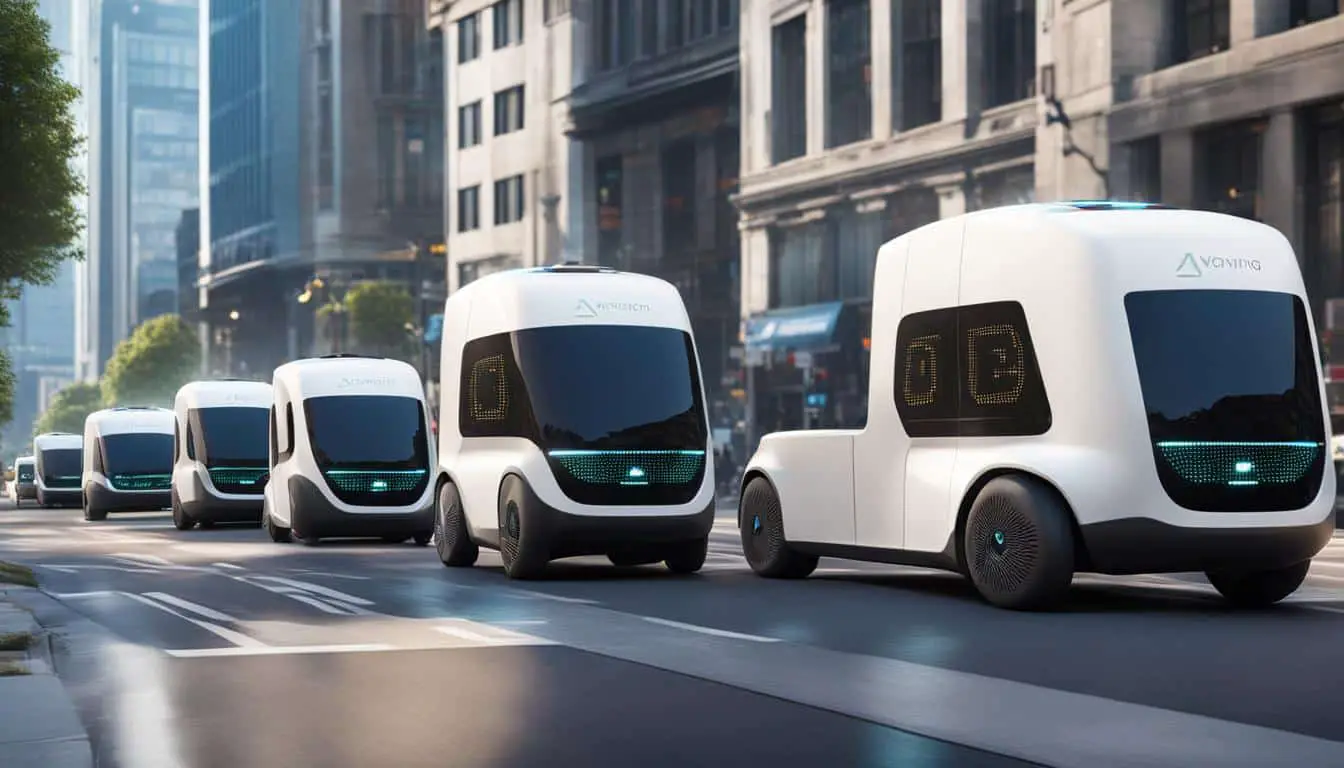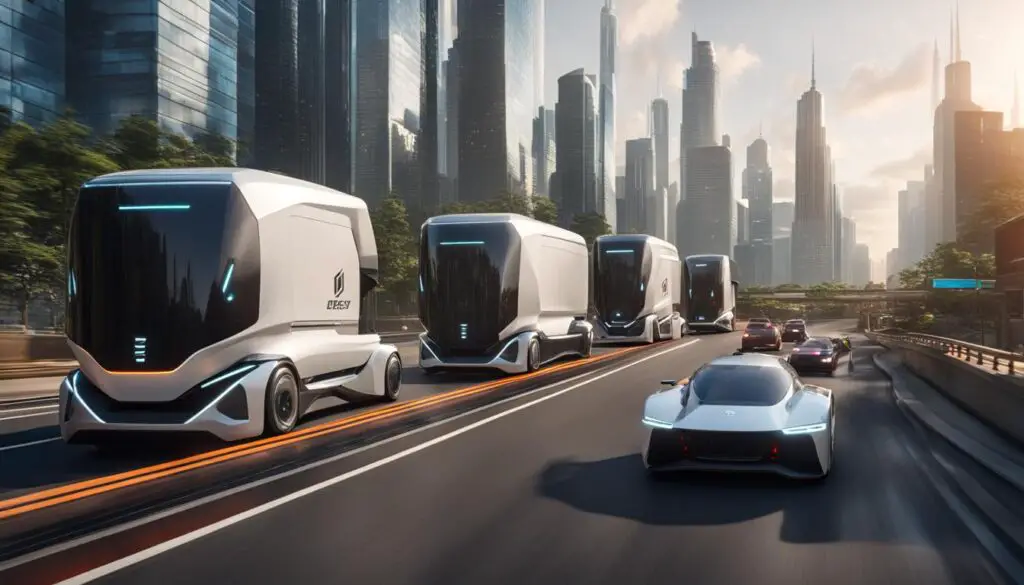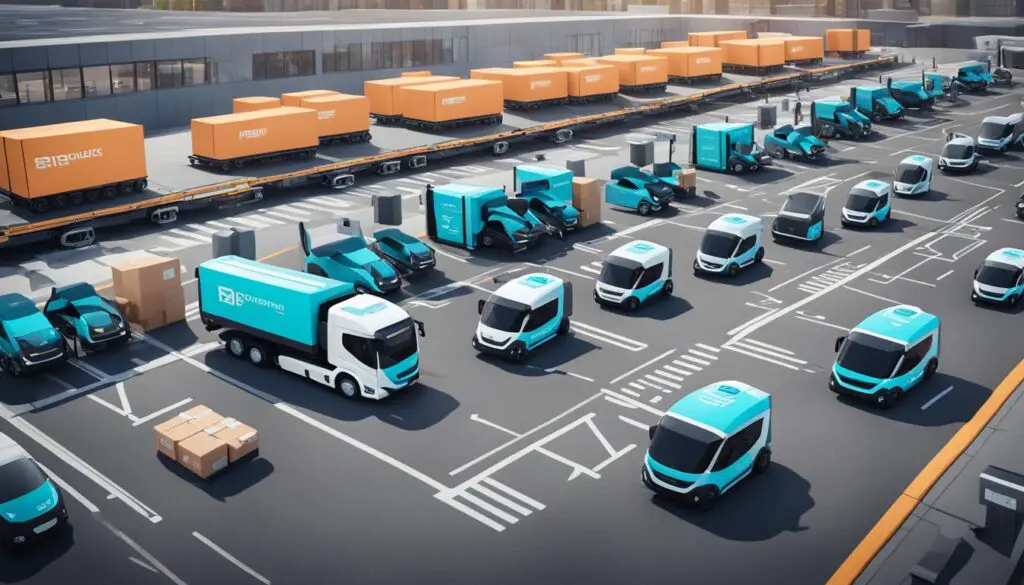
Revolutionizing Logistics and Delivery with Autonomous Vehicle Technology
As a journalist, I am excited to delve into the world of autonomous vehicle technology and its profound impact on the logistics and delivery industries. With advancements in artificial intelligence and machine learning, self-driving cars, trucks, and drones are transforming the way businesses operate and optimizing the supply chain process.
Autonomous vehicles offer a myriad of benefits, ranging from improved efficiency to enhanced reliability. By eliminating the need for human drivers, these vehicles not only reduce costs but also ensure consistent performance and adherence to schedules. They are equipped with sensors and advanced navigation systems, enabling them to navigate complex road networks seamlessly.
Whether it’s self-driving trucks revolutionizing long-distance transportation or autonomous drones streamlining last-mile delivery, logistic companies are embracing these innovative technologies to stay ahead of the competition. The use of autonomous vehicles not only expedites deliveries but also provides real-time data for better inventory management and customer satisfaction.
Key Takeaways
- Autonomous vehicle technology is revolutionizing the logistics and delivery industries.
- These vehicles offer enhanced efficiency, cost reduction, and reliable performance.
- Self-driving trucks and drones are transforming long-distance transportation and last-mile delivery, respectively.
- Real-time data provided by autonomous vehicles improves inventory management and customer satisfaction.
- The adoption of autonomous vehicle technology is essential for businesses to optimize their supply chain operations.
A History of Autonomous Vehicle Development
The development of autonomous vehicles has a rich history that spans several decades. From their humble beginnings in the 1980s to the sophisticated technology we see today, these vehicles have evolved significantly. Advancements in artificial intelligence and machine learning have played a crucial role in driving their widespread adoption.
One of the key milestones in the history of autonomous vehicles was the development of the first self-driving car in the 1980s. This groundbreaking achievement paved the way for further innovation and research in the field. Since then, autonomous vehicle technology has progressed rapidly, with major advancements occurring in the past few years.
The Society of Automotive Engineers (SAE) has established a standardized system for classifying autonomous vehicles based on their levels of autonomy. This system ranges from Level 0, which represents vehicles with no automation, to Level 5, which signifies full automation. Each level represents a specific degree of autonomy, with higher levels indicating increased automation capabilities.
Here is a breakdown of the different levels of autonomy defined by the SAE:
| Level | Description |
|---|---|
| Level 0 | No automation: The driver is fully responsible for operating the vehicle at all times. |
| Level 1 | Driver assistance: The vehicle has basic automated features, such as adaptive cruise control or lane-keeping assistance, but the driver remains responsible for most aspects of driving. |
| Level 2 | Partial automation: The vehicle can assist with steering, braking, and acceleration, but the driver must remain attentive and ready to take control at any time. |
| Level 3 | Conditional automation: The vehicle can operate independently under certain conditions, but the driver must be prepared to intervene when necessary. |
| Level 4 | High automation: The vehicle can perform most driving tasks without human intervention, but it may still require a human driver in certain situations. |
| Level 5 | Full automation: The vehicle is capable of fully autonomous operation in all driving conditions, and no human intervention is required. |
The classification system provides a standardized framework for understanding the capabilities and limitations of autonomous vehicles at different levels of autonomy. It serves as a guide for manufacturers, regulators, and consumers in assessing the technology and its potential applications.
As autonomous vehicles continue to evolve, advancements in technology and research will drive further innovation. The future holds exciting possibilities for the integration of autonomous vehicles into various industries, including logistics and transportation.
The Role of Autonomous Vehicles in Logistics and Transportation
Autonomous vehicles are revolutionizing the logistics and transportation industries, providing innovative solutions for various operational challenges. Self-driving trucks and drones, in particular, have emerged as game-changers in streamlining delivery processes and overcoming logistical hurdles.
Self-driving trucks have significantly impacted long-distance transportation, offering a more efficient and reliable alternative to traditional trucking methods. By leveraging advanced technologies such as artificial intelligence and sensor systems, these autonomous vehicles are capable of navigating routes with precision and reducing delivery times. With the ability to operate continuously without human limitations, self-driving trucks improve the overall transportation process, enhancing supply chain efficiency and customer satisfaction.
On the other hand, autonomous drones are transforming last-mile delivery, especially in congested urban areas where traffic congestion poses a challenge. These agile and unmanned aerial vehicles can navigate through traffic, bypassing road congestion and delivering packages directly to the recipients. The use of drones in logistics enables faster deliveries, reduces the reliance on ground transportation, and enhances accessibility to remote or hard-to-reach locations.
Furthermore, the deployment of autonomous vehicles in logistics and transportation enhances operational safety. Self-driving trucks and drones are equipped with advanced sensor technologies, allowing them to detect and respond to potential hazards in real-time. By eliminating human error and fatigue, these autonomous systems reduce the risk of accidents and ensure safer operations on the road and in the air.
The integration of autonomous vehicles in the logistics and transportation sectors also brings significant environmental benefits. By optimizing routes and reducing unnecessary miles, self-driving trucks and drones contribute to a substantial decrease in fuel consumption and greenhouse gas emissions. This eco-friendly approach aligns with sustainable logistics practices and helps to mitigate the impact of transportation on the environment.
| Advantages of Autonomous Vehicles in Logistics and Transportation | Self-Driving Trucks | Drones |
|---|---|---|
| Enhanced Efficiency | Reduced delivery times and optimized routing | Quick and direct deliveries, bypassing traffic |
| Improved Safety | Elimination of human errors and fatigue | Advanced sensor systems for real-time hazard detection |
| Environmental Sustainability | Optimized routes for reduced fuel consumption | Decreased reliance on ground transportation |
| Flexibility and Accessibility | 24/7 operations without human limitations | Delivery to remote or hard-to-reach locations |
The continued advancements in autonomous vehicle technology, combined with the ongoing research and development efforts from industry leaders, promise a future where logistics and transportation operations are more efficient, safer, and environmentally conscious. As companies embrace these transformative technologies, the role of autonomous vehicles will only continue to expand, unlocking new possibilities in the delivery of goods and services.

Advantages of Autonomous Vehicles in Logistics and Transportation
Autonomous vehicles are revolutionizing the logistics and transportation industries, offering numerous benefits that enhance safety, reduce costs, and improve efficiency. These advancements are reshaping the way goods and services are delivered, paving the way for a more streamlined and reliable supply chain.
Safety Enhancement
One of the key advantages of autonomous vehicles is their ability to eliminate human errors, which account for a significant portion of road accidents. By leveraging advanced sensors, artificial intelligence, and machine learning, autonomous vehicles can detect potential hazards and react swiftly, reducing the risk of accidents. This technology has the potential to save lives and create a safer environment for both drivers and pedestrians.
Cost Reduction
Implementing autonomous vehicles in logistics and transportation can lead to significant cost savings. By eliminating the need for human drivers, businesses can reduce labor costs and mitigate expenses associated with human resources, such as salaries, benefits, and training. Moreover, autonomous vehicles can optimize routes and driving patterns, reducing fuel consumption and maintenance costs.
Efficiency Improvement
Autonomous vehicles offer unparalleled efficiency improvements in the logistics and transportation sectors. By minimizing delivery times and providing real-time data, businesses can optimize inventory management and streamline operations. With autonomous vehicles, goods can be transported more swiftly and reliably, allowing businesses to meet customer demands more effectively.
“Autonomous vehicles have the potential to revolutionize the logistics industry, improving safety, reducing costs, and enhancing efficiency.”
Autonomous vehicles are transforming the world of logistics and transportation, delivering a host of benefits to businesses of all sizes. Safety enhancement, cost reduction, and efficiency improvement are just a few of the advantages that are driving the adoption of autonomous vehicles in these industries.
Table:
| Advantage | Benefit |
|---|---|
| Safety Enhancement | Reduces the risk of accidents by eliminating human errors |
| Cost Reduction | Eliminates the need for human drivers and optimizes routes, reducing labor and maintenance costs |
| Efficiency Improvement | Minimizes delivery times and provides real-time data for better inventory management |
Overall, autonomous vehicles are revolutionizing the logistics and transportation industries by enhancing safety, reducing costs, and improving efficiency. As technology continues to advance, autonomous vehicles will play an increasingly crucial role in shaping the future of logistics and delivery.

Overcoming Challenges in Implementing Autonomous Vehicles
Implementing autonomous vehicles in logistics and transportation comes with its fair share of challenges. In this section, we will explore some of the key obstacles that need to be addressed for the successful integration of autonomous vehicles into our transportation systems.
Regulatory Issues
One of the significant hurdles in implementing autonomous vehicles is the lack of clear rules and regulations. As this technology evolves rapidly, it becomes crucial for regulators to keep pace and establish comprehensive guidelines to ensure the safe and efficient operation of autonomous vehicles. Addressing regulatory issues will not only provide clarity to industry players but also create a level playing field for autonomous vehicle manufacturers and logistics companies.
Public Acceptance and Trust
Another critical challenge is gaining public acceptance and building trust in self-driving vehicles. Many people may have reservations about allowing autonomous vehicles to navigate our roads and transport goods. To overcome this challenge, public awareness campaigns and educational initiatives are essential. By educating the public about the technological advancements and safety measures embedded in autonomous vehicles, we can help foster public acceptance and trust, paving the way for widespread adoption.
Infrastructure Upgrades
The current transportation infrastructure may require upgrades to fully support the operations of autonomous vehicles. This includes the development of smart infrastructure systems that can communicate seamlessly with autonomous vehicles and optimize traffic flow. Upgrading roads, intersections, and charging stations will be necessary to accommodate the specific needs of autonomous vehicles, ensuring their successful integration into our transportation networks.
“Implementing autonomous vehicles in logistics and transportation comes with its fair share of challenges.”
Overcoming these challenges will require collaboration between industry stakeholders, policymakers, and the public. By addressing regulatory issues, building public acceptance, and upgrading infrastructure, we can create an environment that fosters the safe and efficient operation of autonomous vehicles in the logistics and transportation sectors.
| Challenges | Impact | Possible Solutions |
|---|---|---|
| Regulatory Issues | Obstructs widespread adoption and introduces uncertainty. | Establish clear rules and regulations to guide the operation of autonomous vehicles. |
| Public Acceptance and Trust | May hinder the integration of autonomous vehicles into transportation systems. | Educate the public about autonomous vehicle technology and its safety features. |
| Infrastructure Upgrades | Current infrastructure may not be optimized for autonomous vehicle operations. | Upgrade infrastructure to support the specific needs of autonomous vehicles. |
Case Studies: Companies Implementing Autonomous Vehicles
Several companies have embraced the potential of autonomous vehicles and integrated them into their logistics and transportation operations. These case studies highlight the successful implementation of autonomous vehicles and the benefits they bring to the industry.
Waymo
Waymo, a leader in self-driving technology, has made significant strides in utilizing autonomous vehicles for various applications in logistics and transportation. The company has successfully deployed autonomous trucks, revolutionizing the way goods are transported. With the advanced driving capabilities of their self-driving trucks, Waymo has improved delivery times, increased efficiency, and reduced costs for their logistics operations.
By leveraging autonomous vehicle technology, Waymo has optimized supply chain operations, ensuring reliable and timely deliveries. The integration of autonomous vehicles has provided Waymo with a competitive edge in the logistics and transportation industry, allowing them to meet the evolving demands of their customers.
UISEE’s L4 Autonomous Logistics Vehicles
UISEE’s L4 Autonomous Logistics Vehicles have been a game-changer in the logistics industry. These vehicles are equipped with advanced driving capabilities and state-of-the-art technology that allows them to operate autonomously and efficiently. With their cutting-edge sensors and AI-powered systems, UISEE’s vehicles navigate complex logistics environments with ease, ensuring optimal delivery routes and minimizing delays.
The implementation of UISEE’s L4 Autonomous Logistics Vehicles has resulted in improved transportation efficiency, reduced costs, and enhanced safety. These vehicles have the capacity to handle various logistics tasks independently, reducing the need for human intervention and increasing overall operational efficiency.
These case studies demonstrate the effectiveness of autonomous vehicles in the logistics and transportation industry. The successful integration of autonomous technology by Waymo and UISEE has showcased the potential of these vehicles to revolutionize the way goods are transported, improving efficiency, and enhancing overall logistics operations. As more companies witness the benefits of incorporating autonomous vehicles into their operations, the future of logistics and transportation looks promising.
The Future of Autonomous Vehicle Technology in Logistics and Delivery
The rapid advancement of autonomous vehicle technology is poised to transform the landscape of the logistics and delivery industries. As companies increasingly recognize the potential of autonomous vehicles, they are embracing this technology to enhance safety, reduce costs, and improve overall efficiency.
Autonomous vehicles offer a range of benefits in the logistics and delivery sectors. By eliminating human errors, they enhance safety on the roads and minimize the risk of accidents. Through their advanced sensors and intelligent algorithms, autonomous vehicles optimize routes and driving patterns, leading to cost reductions and improved fuel efficiency.
Looking ahead, the future of logistics and delivery with autonomous vehicle technology holds tremendous promise. As technology continues to evolve, we can expect even greater advancements in automation, navigation, and data analytics. These developments will further optimize supply chain operations, streamline last-mile delivery, and revolutionize the way products reach consumers.
However, as with any disruptive innovation, challenges need to be addressed for the full potential of autonomous vehicle technology to be realized. Regulatory frameworks must be established to govern the safe and responsible deployment of autonomous vehicles. Additionally, public acceptance and trust in self-driving technology are crucial, requiring transparent communication and education.
FAQ
What are autonomous vehicles?
Autonomous vehicles are vehicles that can operate without human intervention, using advanced technologies such as artificial intelligence and machine learning to navigate and make driving decisions.
How do autonomous vehicles benefit the logistics and delivery industries?
Autonomous vehicles offer several benefits to the logistics and delivery industries, including enhanced safety, reduced costs, and improved efficiency. They eliminate human errors, optimize routes, and provide real-time data for better inventory management.
What challenges are faced in implementing autonomous vehicles?
Implementing autonomous vehicles in logistics and transportation faces challenges such as regulatory issues, public acceptance, and the need for infrastructure upgrades to support their operations effectively.
Are there any real-world examples of companies using autonomous vehicles?
Yes, several companies have already integrated autonomous vehicles into their logistics and transportation operations. Waymo and UISEE are two notable examples, utilizing self-driving trucks and advanced autonomous logistics vehicles, respectively.
What is the future of autonomous vehicle technology in logistics and delivery?
The future of autonomous vehicle technology in logistics and delivery holds exciting possibilities. As technology continues to advance and companies invest in research and development, we can expect further advancements in safety, efficiency, and reliability.
